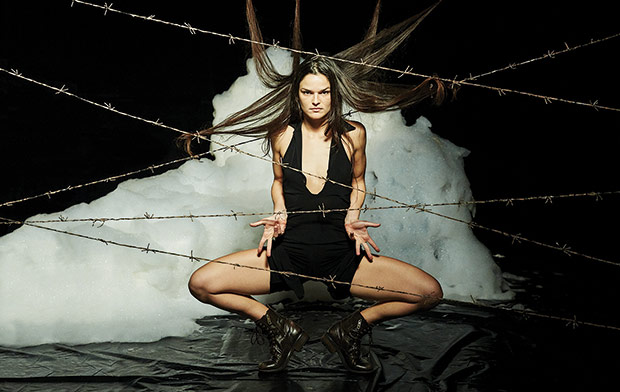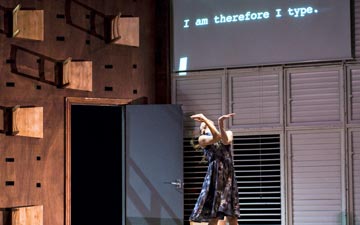
© Simon Clark, graphic design Raanan Gabriel. (Click image for larger version)
Jasmin Vardimon Company
Medusa
★★★✰✰
London, Sadler’s Wells
22 October 2018
jasminvardimon.com
sadlerswells.com
Jasmin Vardimon’s latest work uses mythology to make a powerful point about gender issues in the present day with an overt relevance to the #MeToo movement. It also seeks to rehabilitate the reputation of a much-maligned mythological figure; and – along the way – Vardimon uses the fact that Medusa means jellyfish, in many languages, to express concerns about the environment.
Like many others, my abiding visual mythological reference to Medusa is of the Gorgon slain by Perseus; as in the 1981 film, Clash of the Titans. That reference to Medusa is as an avenging monster, stalking her underground lair, with snakes for hair, and a long, reptilian tail, twitching with the sound of rattlesnakes. She turned men to stone with her stare, but, in beheading her, Perseus becomes the hero. Omitted from this narrative is the back story of how Medusa was turned into a monster by Athena for being raped by Poseidon in her temple. Note that Athena punished Medusa and not Poseidon (in Rome, at the time of Ovid, it was considered a greater crime for a wife to have an affair than to be raped).
Vardimon seeks to make amends by focusing large elements of her powerful dance theatre on the relationship between Medusa and Athena. It is not a narrative work in any linear sense – a significant contrast to her other current work, Pinocchio – but is aimed to reflect the lyrical poetic quality of Ovid, from whose mammoth Latin poem, Metamorphoses, most understanding of the Medusa legend derives.
Throughout the work, there are uncomfortable scenes of male violence against women (being variously kicked, strangled, shot, slashed and punched) and the Poseidon rape is represented choreographically; but there are also many confrontational scenes between, or perpetrated by, women. The multi-talented cast of nine performers seem to swap roles and none are credited as performing any particular character. Australian dancer, Jasmine Orr appears at first to be the most obvious candidate for Medusa – although, dressed in what appeared to be a Hawaiian-style vintage bikini – she was also the lead jellyfish; later, an apprentice dancer from Barcelona, Patricia Hastewell Puig – the production’s poster star – seemed the most likely representation of the title character. The unflinching fixed firmness of her stare certainly suggested the power to turn men into stone. Both these expressive dancers are exciting finds for the future.
Two more experienced performers – Silke Muys and Olga Clavel Gimeno – appeared to take turns in essaying Athena (although it was sometimes hard to tell); both dominating the stage as one might expect from the Goddess of Wisdom and War. There were two random and isolated episodes of quasi-explanatory spoken text by Joshua Smith, which didn’t add a great deal.
The unique selling point of Vardimon’s work lies in her original choreography – imaginative patterned formations in groups and the innovative use of movement to convey characteristics and represent particular actions in highly unusual ways (her Lady and the Tramp and clockwork sequences in Pinocchio are choreographic genius); and in the visual spectacle that she creates (with her partner, Guy Bar-Amotz), often out of the simplest of materials. Both are achieved to some extent in Medusa, although some aspects of the design were disappointing.
The opening is intended to represent the sea through the constant movement of plastic sheeting, but it just looked like plastic sheeting being waved around; similarly, over-large branches were intended to represent stags’ horns (or weapons) but they appeared far too big and unwieldy. The use of rubbish-bins as hats to dispense waste material onto the stage made a powerful environmental point but it also emphasised that this is a work that confuses by focusing on multiple issues simultaneously.
Vardimon’s work tours to a wide variety of venues and another continuing skill has been to make her productions relevant in all sizes of theatre. However, as viewed from the first circle of Sadler’s Wells, the production seemed distant and lacked the necessary intimacy. The characters utter noises to emphasise actions, notably in the Buffy the Vampire Slayer style fight scenes but these sounds were largely drowned in the massive auditorium. Vardimon creates her own sound design – she also wrote the text (with Smith) – which is excellent as a diverse soundscape for the multi-layered choreographic poetry unravelling on the stage; however – and not for the first time at Sadler’s Wells – it was heavily over-amplified and – at times – one felt the music travelling through one’s body rather than just into the ears!
There were many fascinating choreographic elements, not least in the liquid group movement to represent the idea of jellyfish swimming, arms and hands undulating, as if tentacles caught by the waves. There are also sundry references to transformation, such as women as dolls or gossiping at the beach, represented as a pair of deckchairs with sunhats, arms and legs (but no torso). I am as certain as can be that there will have been many other references – Vardimon’s work is always of a high intellectual, academic quality – that I failed to register.
Vardimon’s lyrical production focuses upon both Medusa, the victim, and Athena, the punisher. Not only did Athena turn Medusa into a monster, but she also sent Perseus to behead her (in her sleep, by the way, and not in the contest portrayed in Clash of the Titans); and it is Athena to whom Perseus gives the severed head so that she can use its power. This is #MeToo but with a sting in the tail (or, perhaps, more appropriately from jellyfish tentacles or the snakes of the Gorgon’s hair).

















You must be logged in to post a comment.